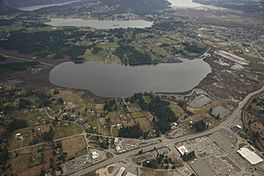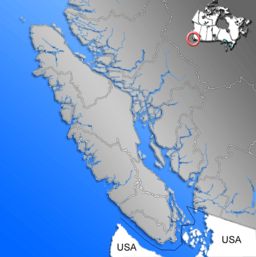Somenos Lake facts for kids
Quick facts for kids Somenos Lake |
|
|---|---|

An Aerial view of Somenos Lake looking from west to east during winter high water. Quamichan Lake can be seen to the east at the top of the image and Cowichan Bay to the south east, is visible to the upper right.
|
|
| Location | North Cowichan, Vancouver Island, British Columbia, Canada |
| Coordinates | 48°48′07″N 123°42′14″W / 48.802°N 123.704°W |
| Primary inflows | Richards Creek, Averill Creek, Bings Creek |
| Primary outflows | Somenos Creek |
| Max. depth | 22.2 feet (6.8 m) |
Somenos Lake is a small, shallow lake located in the area of North Cowichan on Southeast Vancouver Island in British Columbia, Canada. It's an important natural spot for many animals and plants. The lake covers about 247 acres (100 hectares) when the water is high. It is quite shallow, with its deepest point being about 22.2 feet (6.8 meters).
Somenos Lake gets its water from three main streams: Richards Creek, Averill Creek, and Bings Creek. The water then flows out of the lake through Somenos Creek. This creek travels about 4 kilometers (2.5 miles) southeast before joining the Cowichan River.
Contents
Animals of Somenos Lake
Somenos Lake and the streams that feed it are home to many different kinds of fish. It also provides a safe place for many birds and other wildlife.
Fish in the Lake
The lake and its streams have populations of Rainbow trout and Cutthroat trout. These fish live in the lake all the time. Other fish, like Coho salmon and Chum salmon, are anadromous. This means they are born in fresh water, travel to the ocean to grow, and then return to the streams to lay their eggs.
The lake also has native fish species such as Brown bullhead, Three-spined stickleback, and Peamouth chub. However, an invasive species called the Pumpkinseed fish has been in the lake since the 1970s. It is now the most common fish found there.
Birds and Other Wildlife
Besides fish, Somenos Lake and its surrounding marsh areas are a very important winter home for many types of ducks, geese, and swans. A special group of birds that visit are the Trumpeter swans. These large swans arrive at Somenos Lake in October and stay until early April.
Lake Health and Challenges
Over the last 20 years, Somenos Lake has often had large growths of tiny water plants called cyanobacteria. These growths are also known as algae blooms and can make the lake look green and murky during the summer.
These blooms make the lake unsuitable for people to use for activities like swimming, canoeing, or birdwatching. When the large amounts of cyanobacteria die, they use up a lot of the oxygen in the water. This creates anoxic conditions, meaning there isn't enough oxygen for fish like trout and salmon to live comfortably. These blooms happen because there is too much phosphorus in the lake. This extra phosphorus comes from things like trees being cut down (deforestation) and too much fertilizer being used on nearby farms and in towns.
Protecting Somenos Lake
Somenos Lake and its surrounding marsh and wetland areas are looked after by a group called the Somenos Management Committee. This group works to protect the lake and restore its natural habitats. Members of this committee include the Cowichan Tribes, the Municipality of North Cowichan, Ducks Unlimited Canada, and the Somenos Marsh Wildlife Society. They all work together to keep Somenos Lake healthy for everyone.


